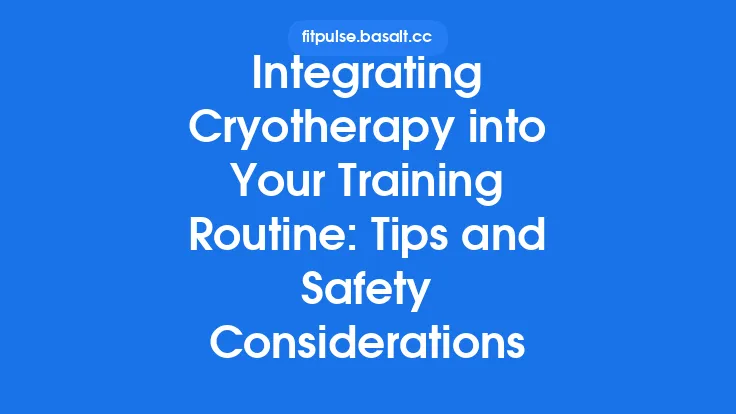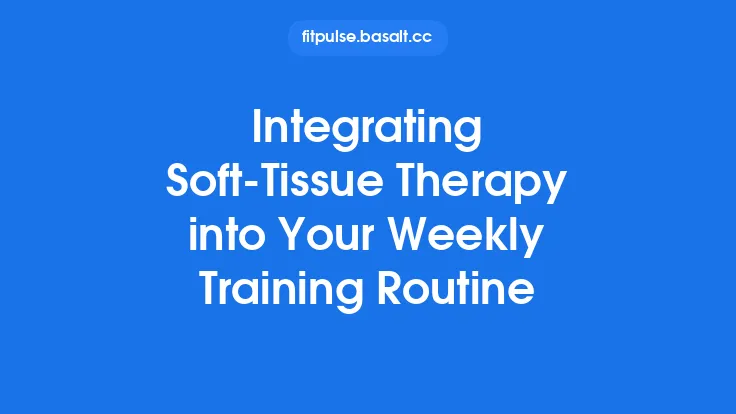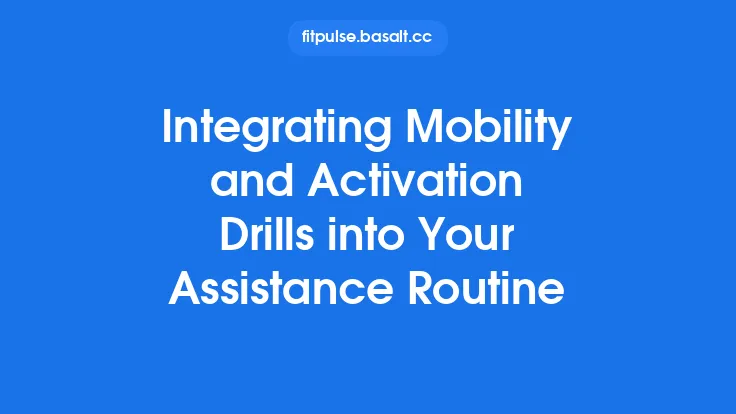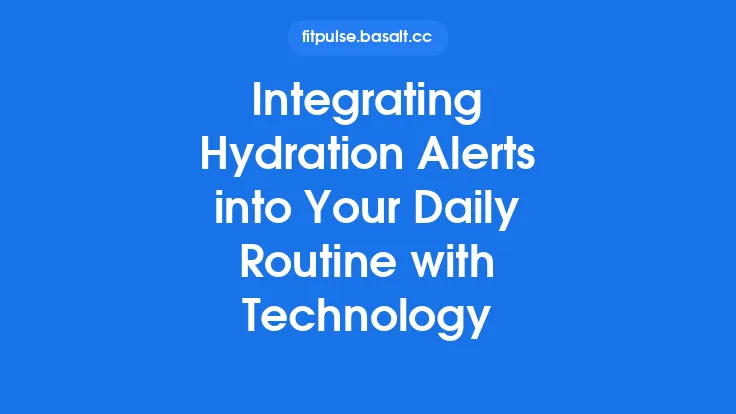Integrating gamification into a personal training routine can transform a mundane workout schedule into an engaging, self‑driven adventure. By borrowing proven game mechanics—points, levels, quests, and feedback loops—and tailoring them to your own fitness objectives, you create a system that constantly nudges you toward improvement while keeping the experience fresh. Below is a step‑by‑step guide that walks you through the process, from conceptualizing the game elements to implementing the technical infrastructure that makes them work seamlessly with the devices and apps you already use.
Understanding Core Gamification Mechanics
Before you start layering game elements onto your workouts, it helps to break down the most common mechanics and what they accomplish:
| Mechanic | Typical Function | How It Translates to Training |
|---|---|---|
| Points | Quantify actions; provide immediate feedback | Assign a numeric value to each rep, set, or minute of activity. |
| Levels | Represent cumulative progress; unlock new content | Move to a higher “trainer level” after reaching a point threshold, granting access to more challenging routines. |
| Experience (XP) | Tracks incremental growth | Award XP for each workout, with diminishing returns for repeated easy sessions to encourage variety. |
| Quests | Structured series of tasks with a narrative hook | Create a “5‑Week Strength Quest” that requires completing specific lifts in a set order. |
| Badges/Achievements | Symbolic milestones that signal mastery | Earn a “5‑K Run” badge after completing a 5‑kilometer run under a target time. |
| Progress Bars | Visual representation of goal proximity | Use a bar that fills as you approach weekly mileage or calorie‑burn targets. |
| Leaderboards (personal) | Competitive ranking | Compare your current week’s points against your own historical best, fostering self‑competition. |
| Virtual Currency | In‑game economy for rewards | Accumulate “FitCoins” that you can “spend” on non‑fitness treats (e.g., a movie night). |
Understanding these building blocks lets you pick the ones that align with your personality and training style, avoiding unnecessary complexity.
Mapping Game Elements to Personal Training Goals
The next step is to align each mechanic with a concrete fitness objective. This mapping ensures that the gamified system reinforces the behaviors you actually want to develop.
| Fitness Goal | Corresponding Game Element | Implementation Idea |
|---|---|---|
| Increase weekly cardio minutes | Points + Progress Bar | 1 point per minute of cardio; bar fills to 150‑minute weekly target. |
| Improve squat strength | Levels + Quests | Level up after every 5 kg increase; quest to complete 3 squat variations in a week. |
| Build consistency | Streak Badges | Earn a “7‑Day Streak” badge for exercising every day for a week. |
| Enhance flexibility | XP + Milestones | Award XP for each yoga session; unlock a “Deep Stretch” milestone after 20 sessions. |
| Reduce resting heart rate | Virtual Currency | Earn FitCoins for each session where post‑exercise HR drops below a threshold; redeem for a rest day. |
By explicitly linking the reward to the desired outcome, you create a feedback loop that naturally guides your behavior.
Selecting the Right Tools and Platforms for Individual Use
You don’t need a full‑blown social fitness network to gamify your routine; many platforms support personal‑only modes or can be customized via APIs. Consider the following categories:
- Wearable‑Centric Apps – Apple Health, Google Fit, Garmin Connect. They already collect granular data (heart rate, steps, calories) and expose it through APIs.
- Task‑Automation Services – IFTTT, Zapier, Make (formerly Integromat). These let you trigger actions (e.g., add points) when a specific metric is logged.
- Spreadsheet‑Based Trackers – Google Sheets or Excel with scripts. Ideal for visualizing points, levels, and progress bars without a dedicated app.
- Custom Mobile Apps – Tools like Thunkable, Adalo, or Flutter can be used to build a lightweight personal gamified app if you want a polished UI.
- Scripting Environments – Python (with `pandas`, `matplotlib`) or JavaScript (Node.js) for deeper data analysis and automated reward calculations.
Pick the stack that matches your technical comfort. For most users, a combination of a wearable app + IFTTT + Google Sheets provides a powerful, low‑code solution.
Setting Up a Personal Points and Level System
A robust points system is the backbone of any gamified routine. Follow these steps to design one that scales with your progress:
- Define Base Activities – List every workout type you perform (e.g., running, cycling, weightlifting, yoga).
- Assign Point Values – Use a weighted formula that reflects intensity and duration. Example:
Points = (Duration_minutes × Intensity_factor) + (Reps × Load_factor)
- Intensity_factor could be MET value for cardio or RPE (Rate of Perceived Exertion) for strength.
- Load_factor could be a percentage of 1RM for weightlifting.
- Create a Level Curve – Decide how many points are needed for each level. A common approach is exponential growth:
Points_for_Level_n = Base_points × (Growth_rate)^(n-1)
- Base_points = 500
- Growth_rate = 1.5
This ensures early levels are easy to achieve, while later levels require sustained effort.
- Automate Point Capture – Use IFTTT to watch for new workout entries in your wearable app and add the calculated points to a Google Sheet via a webhook.
- Visualize Levels – In the sheet, add a column that computes the current level based on cumulative points using a lookup table. Conditional formatting can color‑code the level cell for quick visual reference.
Designing Quests and Milestones for Your Workouts
Quests give structure to otherwise open‑ended training. They can be short‑term (weekly) or long‑term (monthly). Here’s a practical framework:
- Quest Theme – Choose a narrative that excites you (e.g., “Climbing Mount Olympus” for a progressive hill‑run series).
- Task List – Break the quest into 3‑5 discrete tasks, each with its own point reward. Example for a “Strength Builder” quest:
- Complete 3 bench‑press sessions at 70 % 1RM.
- Perform 5 sets of pull‑ups with a 2‑second pause at the top.
- Finish a 5‑km run under 30 minutes (cardio crossover).
- Milestone Rewards – Upon finishing a quest, grant a larger reward (e.g., 200 FitCoins, a new workout playlist, or a “Rest‑Day Pass”).
- Tracking – Add a “Quest Status” column in your sheet. Use data validation dropdowns (Not Started / In Progress / Completed) to keep it tidy.
Because quests are self‑contained, you can design them to target weak points in your program without needing external competition.
Leveraging Wearables and Sensors for Real‑Time Feedback
Real‑time data makes gamification feel immediate and satisfying. Here’s how to integrate sensor streams:
| Sensor | Data Captured | Gamified Use |
|---|---|---|
| Heart Rate Monitor | Beats per minute, HR zones | Award bonus points for staying in target zones; trigger “High‑Intensity Burst” events. |
| Accelerometer / GPS | Steps, distance, speed, elevation | Auto‑generate “Distance Quest” points; calculate elevation gain for mountain‑climb challenges. |
| Power Meter (Cycling) | Watts output | Convert average power into “Power Points” that scale with effort. |
| Force Sensors (Smart Bars) | Repetition speed, bar velocity | Provide instant feedback on lift explosiveness; grant “Speed Bonus” points. |
Most wearables push data to their native cloud (e.g., Apple HealthKit). Use the platform’s webhook or export function to feed the data into your automation pipeline. For example, a Garmin webhook can POST a JSON payload to a Zapier webhook URL, where you parse the payload, compute points, and update your Google Sheet in real time.
Automating Reward Delivery and Progress Visualization
Manual entry defeats the purpose of gamification. Automation keeps the experience fluid:
- Reward Engine – In Google Sheets, create a script (Apps Script) that runs on a timed trigger (e.g., every hour). The script:
- Checks cumulative points.
- Determines if a new level or quest completion threshold has been crossed.
- Updates a “Rewards” tab with earned FitCoins, badges, or level‑up notifications.
- Notification System – Use the `MailApp` service in Apps Script or a Pushbullet integration to send a push notification to your phone whenever you level up or finish a quest.
- Dashboard – Build a simple Google Data Studio (Looker Studio) report that pulls from the sheet:
- Progress Bar for weekly goals.
- Level Timeline showing historical level progression.
- Quest Tracker with visual status icons.
- FitCoin Balance displayed as a circular gauge.
Having a live dashboard turns raw numbers into an intuitive visual story, reinforcing the sense of achievement.
Monitoring Data and Adjusting Difficulty Dynamically
A static point system can become stale. Periodically review your data to keep the challenge appropriate:
- Performance Smoothing – Apply a rolling average (e.g., 7‑day) to key metrics (pace, weight lifted). This smooths out day‑to‑day variance and reveals true trends.
- Difficulty Scaling Rules – Define thresholds that automatically increase point values or quest difficulty. Example:
- If average weekly cardio minutes exceed 120 % of the target for two consecutive weeks, raise the cardio point multiplier by 10 %.
- If squat 1RM improves by >5 % in a month, add a new “Heavy Squat” quest with higher point rewards.
- Feedback Loop – Use conditional formatting in the sheet to flag when you’re consistently over‑ or under‑performing relative to targets. This visual cue prompts you to adjust goals or point values manually.
By embedding these adaptive mechanisms, the gamified system remains a living tool that grows with you.
Integrating Narrative and Theme for Engagement
Even without a multiplayer community, a personal storyline can boost immersion:
- Character Avatar – Create a simple avatar (e.g., a stylized version of yourself) that “levels up” alongside you. Update the avatar’s visual attributes (armor, gear) each time you reach a new level. Tools like Canva or free avatar generators can produce these images, which you can embed in your dashboard.
- Story Milestones – Tie each level to a plot point (e.g., “Level 3 – You’ve crossed the River of Endurance”). Write a short description that appears in the notification when you level up.
- Quest Lore – Frame each quest as a chapter in a larger saga (e.g., “Chapter 2: The Iron Fortress” for a strength‑focused series). This adds context and makes each workout feel purposeful beyond the numbers.
Narrative elements are lightweight to implement but can dramatically increase the emotional connection to the routine.
Evaluating Effectiveness and Iterating Your System
After a few weeks of operation, assess whether the gamified routine is delivering the intended benefits:
- Quantitative Metrics
- Adherence Rate: % of planned workouts completed.
- Progress Velocity: Rate of improvement in key performance indicators (e.g., pace, weight lifted).
- Engagement Score: Average weekly points earned vs. target points.
- Qualitative Feedback
- Keep a brief journal entry after each workout noting motivation, enjoyment, and perceived difficulty.
- Review entries monthly to spot patterns (e.g., “I feel bored when points are too easy”).
- Iteration Cycle
- Identify: Pinpoint any metric that falls below a pre‑set threshold (e.g., adherence < 80 %).
- Adjust: Tweak point values, quest frequency, or difficulty scaling rules.
- Test: Run the adjusted system for another 2–4 weeks before re‑evaluating.
A disciplined review process ensures the gamified framework remains aligned with your evolving fitness goals.
Final Thoughts
Gamification isn’t a magic bullet; it’s a structured set of design principles that, when applied thoughtfully, can turn solitary training into a self‑reinforcing loop of challenge, feedback, and reward. By:
- Defining clear mechanics (points, levels, quests).
- Mapping those mechanics directly to personal fitness objectives.
- Leveraging existing wearables, automation services, and simple spreadsheet dashboards.
- Building adaptive difficulty and a personal narrative.
you create a sustainable, data‑driven training ecosystem that keeps you engaged day after day. The beauty of a personal‑only system is that you retain full control—no external leaderboards, no privacy concerns, and no reliance on premium subscriptions. All that’s required is a willingness to experiment, a modest amount of technical setup, and the curiosity to watch your own progress unfold like a game you’re playing—and winning.





